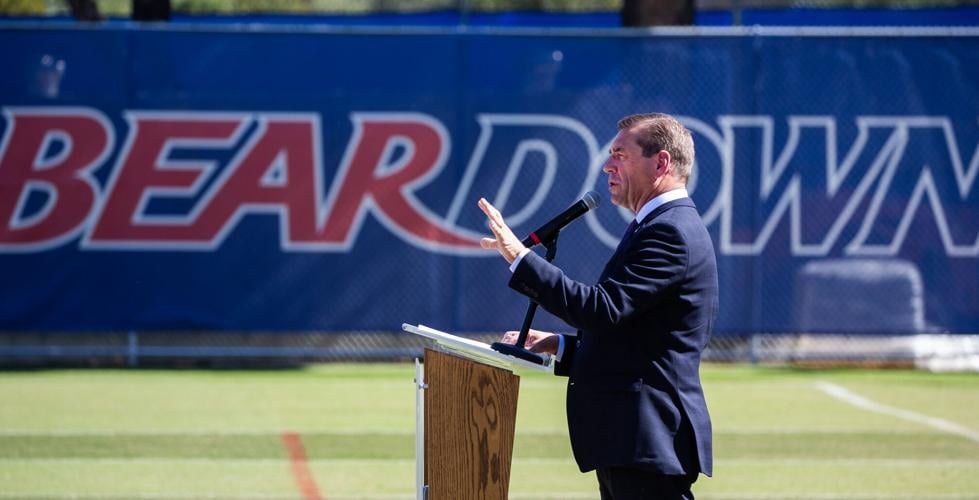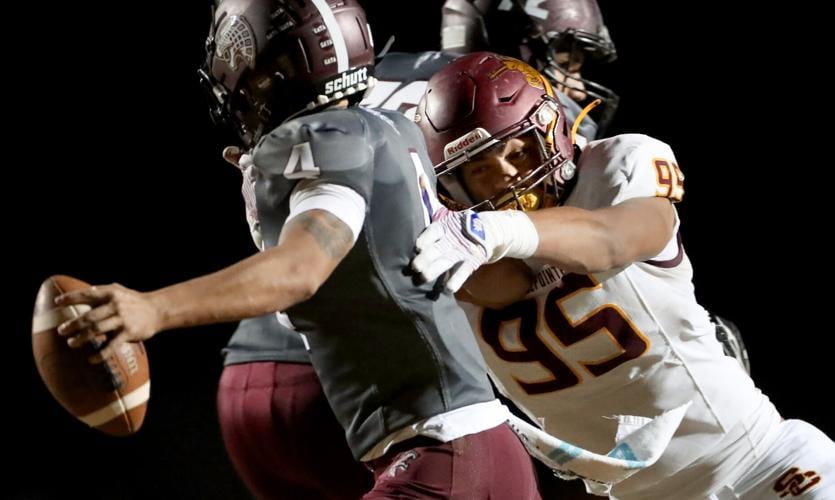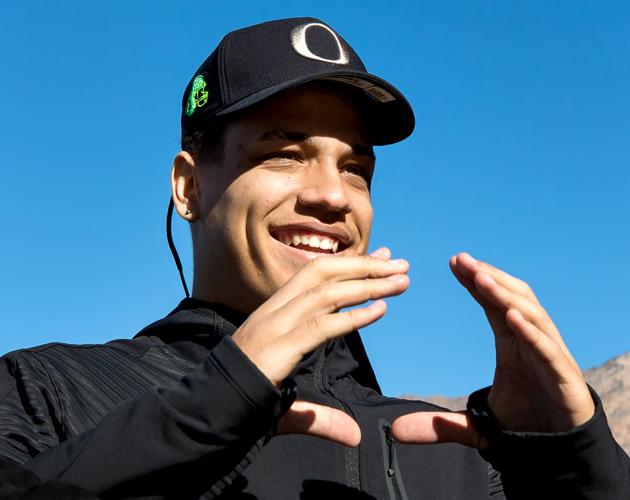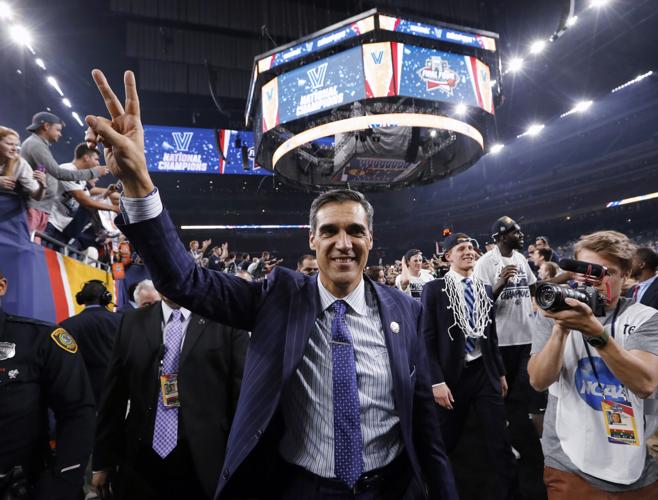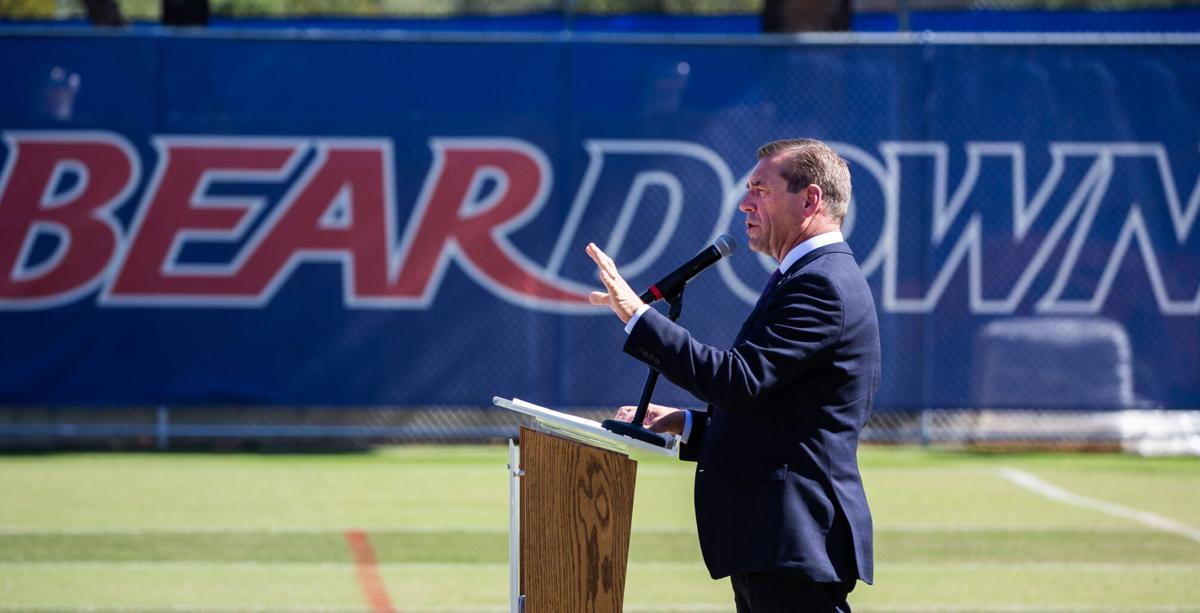The Star's longtime columnist on why Name, Image and Likeness could prove to be a nightmare on Enke Drive, why a Salpointe football player could be the next big thing, and why Jay Wright's departure could be the start of a trend.

Athletic director Dave Heeke
Survivor Dave Heeke, UA athletic department face next terrifying chaper
Dave Heeke is five years into his term as Arizona’s athletic director and a review of those five seasons might appropriately be titled "Nightmare on Enke Drive."
Heeke fired two football coaches and paid about $14 million to expedite their exits. He implemented a humiliating postseason ban for the UA’s men’s basketball team followed by firing coach Sean Miller. More? Head coaches in softball, soccer, gymnastics, baseball, women’s tennis, cross country and swimming left their jobs. The football program lost a Pac-12 record 20 consecutive games.
What’s more, Heeke estimated the athletic department lost close to $40 million in pandemic-related issues.
And yet five years since Heeke left his job as Central Michigan’s AD, it’s clear the Arizona athletic department not only survived the "Nightmare on Enke Drive" but is positioned for one of the school’s most positive and productive periods of the last 20 years.
Perhaps Heeke’s first five years would more appropriately be titled "Survivor."
Just as Heeke, 58, survived an almost unprecedented number of coaching changes and a financial crisis like none in the history of college sports, he must now dig in for Part II: the Name, Image and Likeness era of college sports, the almost certain dissolution of the NCAA and the overflowing transfer portal, which has created free agency for student-athletes.
One of few who can fully understand and appreciate what Heeke has gone through is Tucsonan Jim Livengood, the UA’s athletic director from 1994-2010, a man who experienced almost every conceivable high and low in 30 years as an AD, at Arizona, Washington State, UNLV and Southern Illinois.
"This is a great time to be retired," Livengood said with a laugh. "I can give my opinions without worrying that someone will stop by my desk and say, 'How wrong could you have been?' I would be scared to death of outside influences as they relate to NIL and the transfer portal.
"Everything else is kind of solvable, but there is so much unknown with NIL and the transfer portal that it just scares me. I mean, how much is that next great running back going to cost? How much is the big-name quarterback going to cost? Somebody described it as the ‘wild, wild West’ and it probably is. There are no guardrails in place to prevent some significant problems."
Heeke has become one of the elder statesmen of the Pac-12. Since he arrived at Arizona, athletic directors at Utah, USC, UCLA, WSU and Cal have been replaced. The tenure of ADs in the league has changed significantly in the last 25 years.
In 1997, the average Pac-10 AD stayed on the job for 13½ years. UCLA’s Pete Dalis stayed 19 years, Stanford’s Ted Leland 15 years, USC’s Mike Garrett 18 years, Utah’s Chris Hill 30 years, Oregon’s Bill Moos 13 years and Washington’s Barbara Hedges 14 years.
Today, the longest-tenured Pac-12 AD is Oregon’s Rob Mullens, at 11 years.
"I don’t know how ADs put their heads down at night and sleep peacefully," said Livengood. "I told (ex-Arizona AD) Greg Byrne that their jobs today are so much more difficult than in my era."
The previous six ADs at Arizona all faced monumental challenges, and all were up to the challenge.
Pop McKale created the athletic department, built Arizona Stadium and Bear Down Gym and got Arizona into the Border Conference and on the national map.
Dick Clausen helped to create the WAC and put Arizona into Division I sports, with a much higher national profile. He did the work to get McKale Center built and began the first racial diversity and inclusion process in the athletic department.
Dave Strack hired big-name coaches Fred Snowden, Larry Smith, Jim Young and Jerry Kindall and was involved in getting Arizona into the Pac-10.
Cedric Dempsey turned Arizona into a top-10 athletic department, changed the school’s national reputation and wisely hired Lute Olson, Mike Candrea, Frank Busch and Dick Tomey.
Livengood sustained Dempsey’s work and kept Arizona in the NCAA’s overall rankings for a decade, insisted on being financially responsible, avoiding debt service while holding firm during the departures of Tomey and Olson, and hiring productive coaches Andy Lopez, Sean Miller and Mike Stoops.
Byrne built the $75 million Lowell-Stevens football complex, moved the baseball operation to Hi Corbett Field, hired Adia Barnes and Pac-12 championship coaches Laura Ianello, Clancy Shields, Jim Anderson and Jay Johnson.
Heeke did much more than survive. In the middle of so many troublesome personnel issues, he spent about $120 million to rebuild Hillenbrand softball and swimming facilities, the east side of Arizona Stadium, re-do the core of McKale Center and build the Davis indoor sports center.
What comes next? Probably another series of "Survival" seasons in which the key statistic may become: "Can my donors and boosters out-spend the boosters from USC and Oregon?"

Arizona's Chase Davis won Friday night's rivalry game against Arizona State with a solo home run.
UA slugger Chase Davis a Pac-12 rarity
At the start of the major-league baseball season, MLB executives examined opening day rosters and reported that only 8% of big-league ballplayers are Black, believed to be the lowest percentage in 50 years.
In Pac-12 baseball, Black athletes make up just 7% of 2022 rosters. I reviewed every Pac-12 roster last week and discovered that out of approximately 330 athletes, only 22 Black players are on active rosters; seven are full-time starters.
Sophomore outfielder Chase Davis of Elk Grove, California, is the only Black person on Arizona’s roster. The former No. 1 overall prep baseball recruit out of California, Davis has excelled at Arizona. His epic walk-off, 414-foot home run Friday night to beat Arizona State in extra innings, was Davis’ 12th home run of the season; only Cal’s Dylan Beavers, with 13, has more in the conference.
The lack of Black participation in Pac-12 baseball has been an issue forever. Of the 88 Arizona lettermen to reach the big leagues, only one, center fielder Dwight Taylor, 1980, is Black. That doesn’t include five-time MLB All-Star outfielder Kenny Lofton, who played in just two Arizona games in 1989.
No Pac-12 baseball team employs a full-time Black assistant coach.
Other than Arizona’s Davis, the only other Black baseball player in the Pac-12 with star-level statistics this season is Oregon’s Jacob Walsh, who is hitting .323.
Why the lack of Black college baseball players? Elite teenage male athletes, who specialize in one sport more than at any time in history, have clearly chosen basketball and football as their games of choice.

Salpointe's Elijah Rushing, right, runs down Desert View's Oscar Barraza for a sack late in the second quarter of their high school football game at Desert View High School on Oct. 15, 2021.
Salpointe's Elijah Rushing in demand
In the last 30 days, Salpointe Catholic pass rusher Elijah Rushing has made recruiting visits to Notre Dame, Ohio State, Georgia, Oregon, Ohio State and Northwestern. Before that, he was offered scholarships by Arizona, ASU, Michigan, Florida, Michigan State, Wisconsin, North Carolina, USC and Utah, among others. It’s impossible to know if Rushing, a 4.0 student, is the most heavily recruited Tucson prep football player ever, but he is surely in a small group with Tucson High’s Bill Dawson, Amphitheater’s Michael Bates, Sahuaro’s Mike Ciasca, Sabino’s Mike Saffer and Texas’ Bijan Robinson. Rushing’s older brother, Salpointe grad Cruz Rushing, has already signed with Oregon, and now Cruz and Elijah’s younger brother, David, who enters the eighth grade next year, on the recruiting lists of almost every school in the Pac-12.

Tucson’s Jonah Miller announced that he plans to leave Oregon.
Ex-Duck Jonah Miller could help Cats
It will be interesting to follow the transfer portal experience of ex-Salpointe Catholic offensive lineman Jonah Miller, who announced last week he is leaving Oregon after one season (he redshirted) with the Ducks. The 6-foot-8-inch, 300 pound Miller is one of the most coveted linemen in the transfer portal. Before choosing the Ducks he declined scholarship offers from Arizona, USC, ASU, Texas, Utah and Penn State, among others. Miller could be a difference-maker at a school like Arizona.
Josh Green plays postseason minutes
Nico Mannion has been unable to break into the starting lineup in the Italian EuroLeague this season, averaging 16 minutes and eight points for Virtus, the franchise in Siena, Italy. His backcourt partner at Arizona in 2019-20, Josh Green, has spent the entire season with the Dallas Mavericks, averaging just 4.8 points and failing to get off the bench in 15 regular-season games. But when Dallas star guard Luka Doncic missed a playoff game against Utah last Thursday with injury, Green was given 18 minutes and responded with 12 points.

Men’s tennis coach Clancy Shields has led the Wildcats to their first-ever Pac-12 regular-season title.
Cats will sweat out NCAA selection show
Arizona’s men’s tennis team went undefeated to win the Pac-12 regular season and then lost a first-round conference tournament match to Washington last week? What happened? Coach Clancy Shields’ Wildcats couldn’t beat UW junior Clement Chidekh, who is ranked No. 6 nationally in the NCAA. Chidekh won singles and doubles against Arizona, helping the Huskies to two points when it only takes four points to win a match. The margin for error is slim. The Huskies reached the Pac-12 finals and played against USC on Saturday. Now Shields must sweat out the NCAA’s announcement of the 16 first- and-second round tournament sites. The Wildcats are on the bubble as a first-weekend host.
Julie Brase Hairgrove's run ends
When the WNBA's Phoenix Mercury changed head coaches in the offseason, hiring Vanessa Nygaard to be its head coach, it ultimately led to the end of Julie Brase Hairgrove’s impressive 17-year assistant coaching career with the Mercury. Hairgrove, who set the still-standing girls state career scoring record while at Catalina Foothills High School, 1995-98, had served under five head coaches with the Mercury the last 17 years, helping Phoenix win three WNBA titles. It’s not that she will be without something to keep her busy; Hairgrove's three young daughters are all active in organized sports, including Catalina Foothills cleanup hitter Madison Hairgrove, a sophomore who is hitting .397 for the Falcons, who are ranked No. 3 in Class 5A with a 20-7 record entering next week’s playoffs. To replace Hairgrove, the Mercury hired lead assistant Crystal Robinson, a former WNBA player who has coached for Seattle and Dallas.
Matt Grevers, Rick DeMont in business together
Tucsonan Matt Grevers won six Olympic swimming medals during his remarkable career, appearing in three Olympic Games and being an elite competitor until his mid-30s. Now Grevers embarks a new endeavor. He has gone into partnership with the DeMont Family Swim School in Tucson. That reunites Grevers with his long-time coach, Rick DeMont, a former world-record holder who coached Grevers via the Tucson Ford Dealers Aquatic Club for a decade. DeMont, who retired as Arizona’s head swim coach five years ago, and his wife, Carrie, have operated the DeMont swim school since 2009. Grevers is married to Annie Chandler, a 12-time All-American swimmer at Arizona, a key part of the UA’s 2008 NCAA championship team.

Villanova coach Jay Wright celebrates after wining the 2016 national championship. He retired last week.
My two cents: Jay Wright's departure could be start of trend
When Villanova basketball coach Jay Wright retired last week, stepping away at age 60, it sent a wave of caution through college basketball: Is this just the first elite coach who will retire in his prime, choosing not to deal with the transient nature of the game?
Wright probably was paid close to $35 million in his two decades at Villanova, which is typical of the game’s coaching leaders. It’s difficult not to imagine more coaches like Wright choosing to step away and enjoy their 60s, leaving the uncertainty of year-to-year roster changes and the lack of commitment and loyalty in the game.
Two years ago, Washington football coach Chris Peterson retired at 55 when the Huskies were a national power.
Mental health and peace of mind might become a more powerful draw to those coaches who, nearing 60, have made enough money to retire comfortably.
It’s not that much different than ASU women’s basketball coach Charli Turner Thorne choosing to retire last month at age 55. Turner Thorne coached the Sun Devils for 27 seasons and although her career ASU earnings were closer to $12-15 million than Wright’s estimated $35 million, she chose to step away and smell the flowers.
Whether intended or not, Wright and Turner Thorne have given notice that the expected-retirement-age for too-shelf college coaches is entering a period of adjustment. Arizona’s Tommy Lloyd, 47, and Adia Barnes 45, are just entering the prime of their coaching lives. Both earn in excess of $1 million a year. Both have young families (Lloyd has three children; Barnes two) and they work what can be described as a 24/7 occupation.
Even if all goes well the next 15 years, what are the odds they will still be coaching at Arizona in 2037? It probably won’t be a question of money as much as it will be a quality-of-life and peace-of-mind decision.


